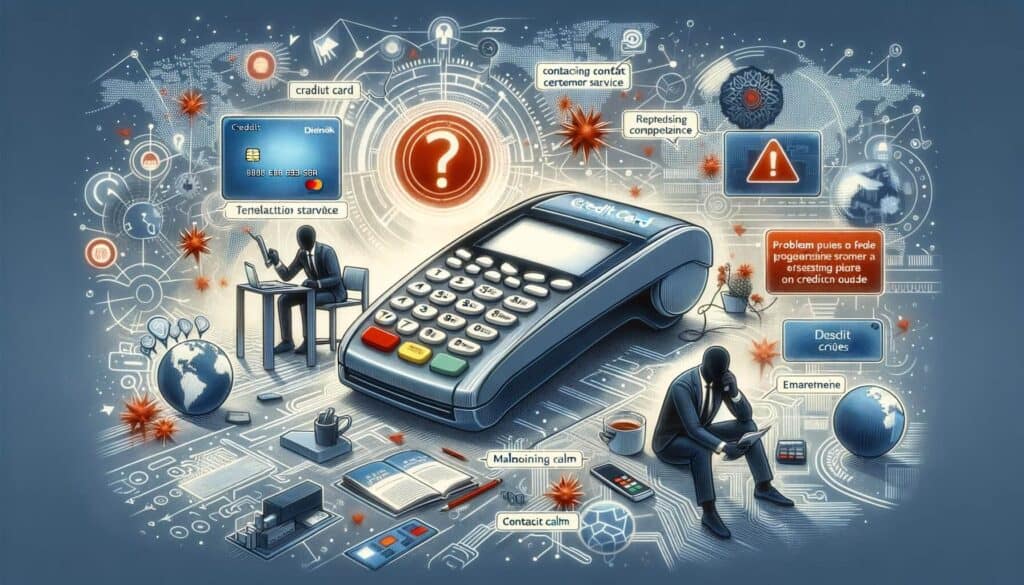
By Carol Peters December 28, 2024
In today’s digital age, credit card processing has become an integral part of conducting business transactions. However, like any technology, credit card processing systems are not immune to outages. A credit card processing outage refers to a temporary disruption in the ability to process credit card payments, which can have significant implications for businesses.
In this article, we will explore the causes of credit card processing outages, their impact on businesses, and how to handle them effectively.
Causes of Credit Card Processing Outages

Credit card processing outages can occur due to various reasons, ranging from technical glitches to external factors. One common cause is system failures or malfunctions within the credit card processing infrastructure. These failures can be attributed to hardware issues, software bugs, or network connectivity problems. Additionally, cyberattacks, such as Distributed Denial of Service (DDoS) attacks, can also disrupt credit card processing systems.
Another cause of credit card processing outages is scheduled maintenance or upgrades. Payment processors often need to update their systems to enhance security, add new features, or comply with regulatory requirements. During these maintenance windows, businesses may experience temporary disruptions in credit card processing.
External factors, such as natural disasters or power outages, can also lead to credit card processing outages. For example, severe weather conditions or infrastructure failures can disrupt the power supply, rendering credit card processing systems inoperable.
Impact of Credit Card Processing Outages on Businesses

Credit card processing outages can have a significant impact on businesses, both financially and operationally. Firstly, businesses may experience a loss of revenue during the outage period. If customers are unable to make credit card payments, they may choose to abandon their purchases or seek alternative payment methods. This can result in missed sales opportunities and potential damage to the business’s reputation.
Furthermore, credit card processing outages can disrupt the overall customer experience. Customers expect seamless and convenient payment options, and any interruption in credit card processing can lead to frustration and dissatisfaction. This can negatively impact customer loyalty and retention, as well as the overall perception of the business.
Operationally, credit card processing outages can cause delays in order fulfillment and inventory management. Without the ability to process payments, businesses may struggle to complete transactions and track inventory accurately. This can lead to logistical challenges and potential disruptions in the supply chain.
Preparing for a Credit Card Processing Outage
While credit card processing outages are unpredictable, businesses can take proactive measures to minimize their impact. One crucial step is to have a contingency plan in place. This plan should outline alternative payment options, communication strategies, and troubleshooting procedures to be followed during an outage.
Businesses should also consider diversifying their payment options. By offering multiple payment methods, such as cash, checks, or mobile wallets, businesses can ensure that they can continue accepting payments even during a credit card processing outage. Additionally, having a backup payment processor or a secondary merchant account can provide an alternative means of processing credit card payments in case of an outage.
Steps to Take During a Credit Card Processing Outage

When faced with a credit card processing outage, businesses should follow a systematic approach to minimize disruptions and maintain customer satisfaction. The following steps can help businesses navigate through an outage effectively:
1. Identify the issue: The first step is to determine whether the outage is specific to your business or if it is a widespread issue affecting multiple merchants. Contact your payment processor or check their website for any announcements or updates regarding the outage.
2. Communicate with your team: Inform your staff about the outage and provide them with clear instructions on how to handle customer inquiries and transactions. Ensure that they are aware of alternative payment options and troubleshooting procedures.
3. Implement alternative payment methods: Activate alternative payment options, such as cash, checks, or mobile wallets, to ensure that customers can still make purchases. Train your staff on how to process these alternative payments and update your point-of-sale systems accordingly.
4. Keep customers informed: Proactively communicate with your customers about the outage through various channels, such as social media, email, or in-store signage. Provide clear instructions on alternative payment methods and any potential delays in order fulfillment.
5. Maintain customer service: During an outage, it is crucial to provide exceptional customer service to mitigate any negative impact. Train your staff to handle customer inquiries and complaints with empathy and efficiency. Offer solutions, such as discounts or vouchers, to compensate for any inconvenience caused.
Alternative Payment Options During a Credit Card Processing Outage

During a credit card processing outage, businesses need to have alternative payment options in place to ensure uninterrupted sales. Here are some alternative payment methods that businesses can consider:
1. Cash: Accepting cash payments is the most straightforward alternative during an outage. Ensure that you have sufficient change on hand and train your staff on cash handling procedures.
2. Checks: Accepting checks can be an option for businesses during an outage. However, it is essential to have a robust check verification process in place to minimize the risk of fraudulent checks.
3. Mobile wallets: Encourage customers to use mobile wallet apps, such as Apple Pay or Google Pay, to make payments. These apps allow customers to link their credit or debit cards to their smartphones, enabling contactless payments.
4. Gift cards or store credit: If your business offers gift cards or store credit, encourage customers to use them as an alternative payment method during an outage. This can help maintain customer loyalty and ensure future sales.
5. Manual credit card processing: In some cases, businesses may be able to process credit card payments manually. This involves taking an imprint of the customer’s credit card using a manual imprinter and completing a paper credit card slip. However, this method should only be used as a last resort, as it carries a higher risk of fraud and chargebacks.
Communicating with Customers During a Credit Card Processing Outage
Effective communication with customers is crucial during a credit card processing outage to minimize confusion and maintain trust. Here are some strategies for communicating with customers during an outage:
1. Proactive communication: As soon as you become aware of the outage, inform your customers through various channels, such as social media, email, or in-store signage. Clearly explain the issue, provide alternative payment options, and assure customers that you are working to resolve the problem.
2. Update your website: Display a prominent message on your website’s homepage informing customers about the outage and alternative payment methods. Regularly update the message to keep customers informed about the progress of the resolution.
3. Utilize social media: Leverage your social media platforms to communicate with customers in real-time. Post regular updates about the outage, answer customer inquiries promptly, and address any concerns or complaints.
4. Email notifications: Send out email notifications to your customer database, informing them about the outage and providing alternative payment options. Personalize the emails to show that you value their business and apologize for any inconvenience caused.
5. In-store signage: Display clear and visible signage in your physical store, informing customers about the outage and alternative payment methods. Train your staff to direct customers to the signage and provide assistance if needed.
Troubleshooting Credit Card Processing Outages
While credit card processing outages are beyond a business’s control, there are troubleshooting steps that can be taken to resolve the issue promptly. Here are some troubleshooting tips:
1. Contact your payment processor: Reach out to your payment processor’s customer support immediately to report the outage. Provide them with all relevant details, such as error messages or any recent changes made to your system.
2. Check your internet connection: Ensure that your internet connection is stable and functioning correctly. A poor or intermittent internet connection can cause disruptions in credit card processing. Restart your router or contact your internet service provider if necessary.
3. Restart your point-of-sale system: Sometimes, a simple system restart can resolve minor glitches or software issues. Power off your point-of-sale system, wait for a few seconds, and then power it back on. This can help refresh the system and establish a stable connection with your payment processor.
4. Verify hardware connections: Check all hardware connections, such as cables and card readers, to ensure they are securely plugged in. Loose connections can cause intermittent disruptions in credit card processing.
5. Update software and firmware: Ensure that your point-of-sale software and firmware are up to date. Outdated software can be vulnerable to bugs or compatibility issues, leading to processing errors.
Preventing Future Credit Card Processing Outages
While it is impossible to completely eliminate the risk of credit card processing outages, businesses can take preventive measures to minimize their occurrence. Here are some strategies to prevent future credit card processing outages:
1. Regular system maintenance: Schedule regular maintenance windows to update and maintain your credit card processing systems. This includes installing software updates, testing hardware components, and ensuring network connectivity.
2. Backup power supply: Invest in a backup power supply, such as an Uninterruptible Power Supply (UPS), to ensure that your credit card processing systems remain operational during power outages. This can help prevent disruptions caused by external factors.
3. Redundant systems: Consider implementing redundant systems or backup payment processors to ensure continuity in credit card processing. Having a secondary merchant account can provide an alternative means of processing payments in case of an outage with your primary processor.
4. Security measures: Implement robust security measures, such as firewalls, intrusion detection systems, and encryption protocols, to protect your credit card processing systems from cyberattacks. Regularly update your security software to stay ahead of emerging threats.
5. Monitoring and alerts: Utilize monitoring tools and alerts to proactively identify and address potential issues before they escalate into outages. Monitor system performance, network connectivity, and transaction logs to detect any anomalies or signs of impending failures.
Frequently Asked Questions (FAQs)
Q1. What should I do if my credit card processing system goes down?
If your credit card processing system goes down, the first step is to identify the issue and determine its scope. Switch to alternative payment methods, such as cash or mobile payments, and communicate the situation to your customers. Contact your payment processor’s support team for further assistance.
Q2. How can I prevent credit card processing outages?
Regular system maintenance, updates, and robust cybersecurity measures can help prevent credit card processing outages. Work closely with your payment processor to schedule maintenance windows during off-peak hours and invest in cybersecurity measures to protect your systems.
Q3. Can I seek compensation for losses incurred during a credit card processing outage?
If your credit card processing agreement includes service level agreements (SLAs), you may be eligible for compensation for losses incurred during an outage. Review your agreement and contact your payment processor to discuss the possibility of compensation.
Q4. How can I communicate with customers during a credit card processing outage?
Communicate with customers through various channels, such as email, social media, or website notifications. Inform them about the outage, provide alternative payment options, and regularly update them on the progress of resolving the issue.
Conclusion
Credit card processing outages can disrupt businesses’ ability to process payments and have significant financial and operational implications. By understanding the causes of these outages, businesses can take proactive measures to minimize their impact.
Preparing for an outage, implementing alternative payment options, effectively communicating with customers, troubleshooting issues, and preventing future outages are essential steps in handling credit card processing outages. By following these strategies, businesses can navigate through outages smoothly, maintain customer satisfaction, and ensure uninterrupted sales.
